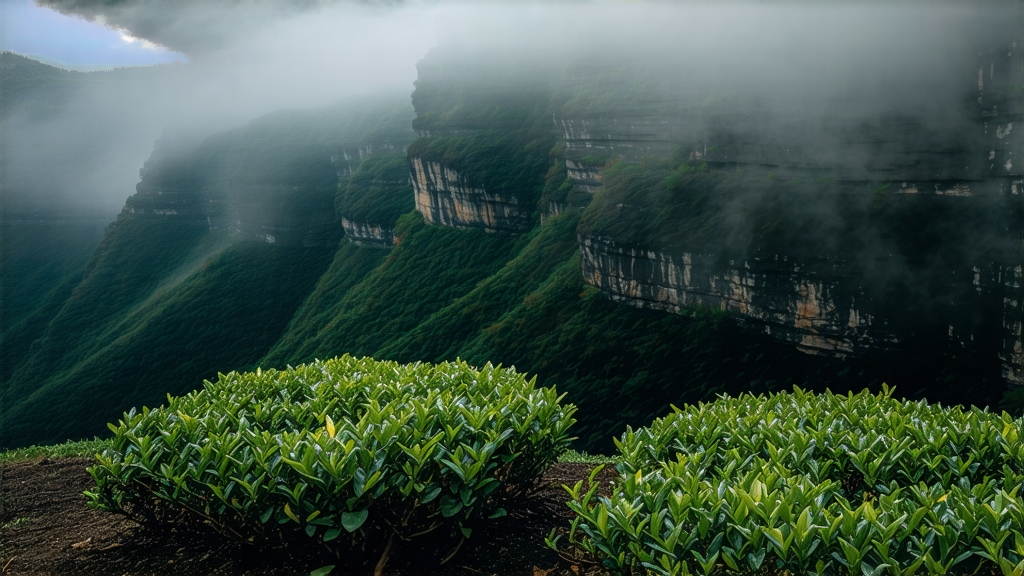
If green tea is the dewy youth of Chinese tea and pu-erh its wise elder, then Da Hong Pao—Big Red Robe—occupies the dramatic middle act: mature, charismatic, and wrapped in legend. Grown on the vertiginous basalt cliffs of northern Fujian’s Wuyi Mountains, this oolong commands attention with every sip, delivering a spectrum of flavors that oscillate between orchid nectar, roasted stone fruit, and the mineral snap of wet slate after a thunderstorm. For centuries it has been the gift offered to emperors, the subject of poetry, and the catalyst for midnight debates among tea traders. Today it remains the flagship cultivar that international connoisseurs cite when arguing that China still guards the soul of oolong.
Historical whispers place the birth of Da Hong Pao during the Ming dynasty, when a scholarly monk or, in some tellings, a Ming court official recovered from illness after drinking tea plucked from six ancient bushes clinging to Tianxin Rock. In gratitude he draped his imperial red robe over the shrubs, giving the tea its evocative name and royal cachet. By the Qing era the six “mother trees” had become state property; their leaves were compressed into small “tribute cakes” and escorted to Beijing under armed guard. When the last emperor fell, the trees survived both revolution and war, quietly producing a few hundred grams annually until 2006, when the Chinese government declared them off-limits for harvesting to protect the genetic legacy. Today what circulates in the market are descendants—either direct cuttings (qiezhi) or sexually propagated seedlings (shizhong)—yet the mystique of those original bushes still steers price and desire.
Botanically, Da Hong Pao belongs to the Wuyi qi zhong (“strange cultivar”) collective, a local family of tea bushes adapted to thin, mineral-rich soils and temperature swings created by mountain mists. The most prestigious clonal line is Bei Dou #1, a cutting taken from the mother trees in the 1980s and now cultivated in limited pockets of the Wuyi core scenic zone. Other garden-worthy siblings include Qi Dan and Que She, each offering subtle shifts in aroma: Bei Dou leans toward cinnamon and burnt sugar, Qi Dan whispers of jasmine and wet limestone, while Que She finishes with a cooling spearmint note. Regardless of clone, true Wuyi Yan Cha—literally “cliff tea”—must grow within the 60-square-kilometer UNESCO heritage buffer where volcanic rock dominates the substrate; outside that radius the same cultivars lose the coveted “yan yun” or rock rhyme, that tingling mineral echo that lingers in the throat long after the cup is empty.
Crafting Da Hong Pao is a month-long choreography of stress and rest. Picking occurs in late April when two leaves and a bud are still stiff with overnight dew. The first step, wilting, is done outdoors on bamboo screens set among the cliffs themselves so that leaves inhale the canyon’s cool, resinous air. Once the edges soften, processors move indoors for yaoqing—rhythmic tossing in bamboo drums that bruises the leaf margins just enough to coax oxidation enzymes from their cellular chambers. Oxidation is arrested at roughly 40 %, the sweet spot where green chlorophyll yields to amber but polyphenols retain enough backbone for later aging. Then comes the Wuyi signature: charcoal roasting in squat, brick kilns. Using only local hardwood such as longan or lychee, masters maintain a low 80 °C ember for eight to twelve hours, rest the tea for a week, and repeat the cycle up to three times. The result is a leaf that looks almost black yet hides a maroon underbelly; its fragrance is campfire and honey, its liquor the color of antique mahogany.
To brew Da Hong Pao well one must think like a mountain guide: respect the terrain, pack light, and listen. A small 120 ml gaiwan or Yixing zisha teapot seasoned only for Yan Cha is ideal. Rinse the vessel with boiling water, then fill one-third full of dry leaf—more than you think you need. The first infusion, a flash rinse, wakes the leaves and washes away roasting dust; discard it. Subsequent steeps start at five seconds, adding two seconds each round. Water should be just off a rolling boil, 98–100 °C, and preferably drawn from a TDS-neutral spring; hard municipal water mutes the mineral song. Expect at least seven infusions: the first